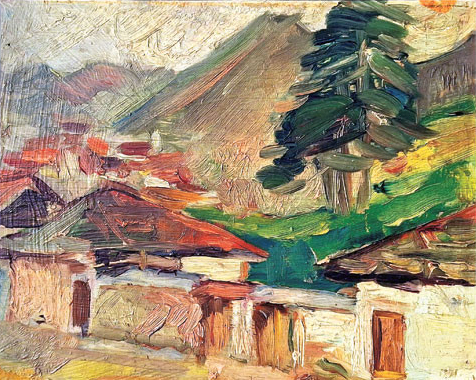The Serbian art world has been enriched by an extraordinary discovery—a previously unknown painting by Nadežda Petrović, tentatively titled Landscape and believed to have been created around 1913, has been authenticated as a genuine work of one of Serbia's most renowned painters. This breakthrough is the result of a unique collaboration between the National Museum of Serbia and the Vinča Institute of Nuclear Sciences, which played a key role in the verification process using cutting-edge scientific methods.
The authenticity of Landscape was confirmed following extensive pigment analysis using EDXRF spectrometry, conducted at the Vinča Institute. Completely non-destructive and non-invasive, this technique allowed the identification of materials used in the painting and their comparison with pigments typical of the early 20th century, when Nadežda Petrović was active.
 Painting by Nadežda Petrović under the working title "Landscape", around 1913. (Photo private archive)
Painting by Nadežda Petrović under the working title "Landscape", around 1913. (Photo private archive)
"For over two decades, the Vinča Institute has actively applied scientific methods to the study of cultural heritage. Our work is based on technologies that fully preserve the integrity of artworks, which is crucial for this type of research," said Dr. Maja Gajić Kvaščev, Senior Research Fellow at the Vinča Institute, during her appearance on the Belgrade Chronicle program.
The analyses performed at the Vinča Institute demonstrate how advanced science can serve the preservation of cultural heritage. In the case of Landscape, a privately-owned painting, the Institute's scientific team successfully identified the original pigments, confirming its authenticity.
"In addition to conducting analyses in our laboratories, we can also carry out research on-site, which makes us particularly flexible. This capability has earned us recognition as a regional leader, and our goal is to become a regional center for cultural heritage studies in the near future," emphasized Dr. Gajić Kvaščev.
Beyond authenticating Landscape, scientists from the Vinča Institute have contributed to numerous significant projects, such as reconstructing the painting Grand Isa and the iconostasis of the Nikolajevska Church, the oldest church in Belgrade, located in Zemun.
"The Vinča Institute actively develops scientific methods that enable better understanding and preservation of cultural heritage through its projects and collaborations with other institutions. Our technologies represent an unbreakable link between science and culture," added Dr. Gajić Kvaščev.
The scientists of the Vinča Institute continue to demonstrate how science can serve society, culture, and history, setting new standards in cultural heritage protection. Aiming to become a regional hub for cultural heritage research and preservation, the VINARCH Center for Archaeometry, established by the Vinča Institute and the Archaeological Institute, leads the field of non-destructive analyses. Simultaneously, it continuously enhances methodologies and strengthens cooperation with other institutions, making science not only a driver of technological progress but also a cornerstone of cultural and societal development.
For more on this story, read the article "A Newly Discovered Painting by Nadežda Petrović" published in Politika at the following link:
https://www.politika.rs/scc/clanak/648187
You can also watch Dr. Maja Gajić Kvaščev's guest appearance on the Belgrade Chronicle program at this link:
https://www.rts.rs/magazin/kultura/nesto-drugo/5595940/institut-vinca-fizika-analiza-umetnickih-dela.html?utm_medium=Social&utm_source=Facebook#Echobox=1733346089



